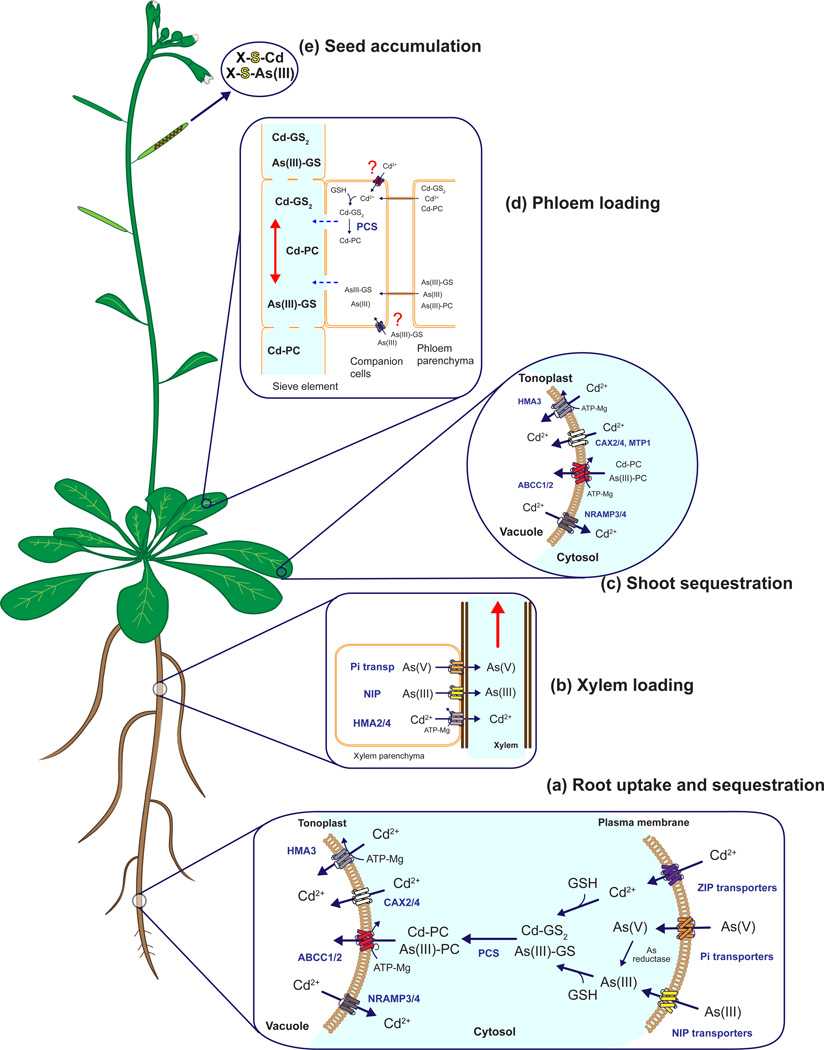Figure 1.
Uptake, sequestration and long-distance cadmium and arsenic transport mechanisms in plants.
(a) Cadmium (Cd2+) uptake, at the root level, is mediated by ZIP transporters (i.e. IRT1 transporter) and other divalent metal nutrient transporters. Arsenic, depending on the redox state [As(V) or As(III)], may be taken up by phosphate transporters [As(V)] [33] or nodulin 26-like proteins [As(III)] [4–5]. Once inside the cell As(V) is readily reduced to As(III). Cd2+ and As(III) induce phytochelatin (PC) synthesis in the cytosol and PC-metal(loid) complexes are sequestered into vacuoles by ABCC transporters (ABCC1 and ABCC2 in Arabidopsis [9]). ABCC1 and ABCC2 can also transport GS-X conjugates into vacuoles [16]. Cd2+ can also be sequestered into vacuoles by HMA3 and proton/cation exchange transporters (CAX-type transporters). Cadmium can also be released from the vacuole by NRAMP-type transporters [72–73].
(b) Loading of Cd2+ into the xylem for root-to-shoot transport of Cd2+ is mediated by the ATPases HMA2 and HMA4 [39,63]. Similar to root-uptake, NIP-like transporters mediate As(III) loading into the xylem while phosphate transporters mediate loading of As(V) [4–5].
(c) As(V) may also be reduced in leaves to As(III). Phytochelatins induced by Cd2+ or As(III) in leaves are transported into vacuoles by ABCC transporters. Similar to root vacuoles, Cd uptake is also mediated by CAX-type and MTP-type transporters [4–5]. Depending on the species, metal(loid)s may be accumulated in epidermal or mesophyll cells [4,74].
(d) If Cd2+ and As(III) are not fully sequestered in leaf vacuoles, they can reach phloem parenchyma and companion cells through plasmodesmata (symplastic transport). Due to the high permeability of companion cells and sieve element plasmodesmata, GSH, As(III)- or Cd-induced PCs synthesized in companion cells may enter the phloem stream symplastically and be transported from source-to-sink (i.e. to young leaves, seeds and roots) [35].
(e) EXAFS analysis in the Cd hyperaccumulator Thlaspi praecox showed that 60% of Cd in seeds is complexed with thiol-containing compounds [42] and a similar mechanism was also proposed for arsenic accumulation in rice grains [75].

